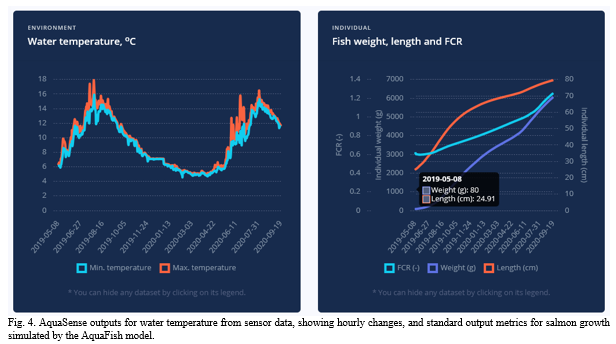AQUASENSE – A REAL-TIME PRECISION AQUACULTURE PLATFORM FOR INDUSTRY
Introduction
The EU Horizon 2020 G reen A quaculture Intensification in Europe (GAIN) project aims to promote eco-intensification of aquaculture by investigating several complementary strategies, including feed improvements, better use of secondary products, and precision aquaculture.
The development of precision aquaculture has four requirements: (i) deployment of sensors that supply environmental data on drivers of growth, welfare, disease, and mortality; (ii) detection of measurable response metrics from cultivated species—growth and mortality rates are the most significant; (iii) coupling and interpretation of these input and response data in order to obtain quasi- or real-time information on the cultivation process, providing farmers with meaningful indicators; and (iv) integrated platforms where industry stakeholders can easily access, process, and make use of data and information in order to optimise their activity in terms of production, environmental, and economic outcomes.
We present a blueprint of the AquaSense platform (https://aquasen.se), which was designed to meet these requirements, as part of the GAIN approach to increasing aquaculture yield in Europe by making better and more sustainable use of existing space and resources.
Methodology
AquaSense is a cloud-based platform that enables users to retrieve environmental data acquired using sensors deployed in or near cultivation structures such as cages, longlines, or trestles, and use those data to apply state-of-the-art mathematical models of growth and environmental effects.
AquaSense clients enter (or use stored) data on culture practice, including the duration of the culture period, initial stocking density, and mortality rates (
) , and the platform retrieves the relevant environmental data from a storage hub. For finfish, water temperature is the main driver of growth, and for bivalves such as mussels or oysters, data on the natural food supply are also retrieved, since these organisms are organic extractors and do not require additional feeding.
The well-tested (e.g. Ferreira et al, 2012; Saurel et al, 2014; Cubillo et al, 2016 ) ‘Aqua’ series of models (
) is used to predict growth and environmental effects for key species grown in Europe, including Atlantic salmon (Salmo salar), Rainbow trout (Onchorhynchus mykiss), European seabass (Dicentrarchus labrax ), g ilthead bream (Sparus aurata), Pacific oyster (Magallana gigas), blue mussel (Mytilus edulis), Mediterranean mussel (M. galloprovincialis), and Manila clam (Ruditapes philippinarum).
Apart from growth, AquaFish provides outputs on feed ingestion and particulate waste, oxygen consumption, and excretory products.
The AquaSense platform simulates the growth of the selected culture organism based on the culture data and environmental drivers retrieved from in situ sensors and scales up the results to the cages (or other structures such as mussel longlines) defined by the farmer. These results at the farm and individual scale are displayed to the user in graphical form for easy interpretation. Any growth period, starting weight, etc can be simulated by the user.
Results and Discussion
Example results from the application of AquaSense to Atlantic salmon in Norway are shown below (Fig 3).
In addition to these results, individual performance metrics are also provided, together with growth curves over the culture period (Fig 4).
The outputs from AquaSense help farmers review how the harvested crop relates to changes in environmental conditions and evaluate the emissions footprint of their activity. The first component is important in terms of optimising production and understanding deviations from expected growth performance, and the second helps farm managers and water authorities assess the sustainability of the activity, particularly in light of co-use of water bodies, source apportionment of nutrient emissions, and legislative compliance.
In order to expand the reach of this system, GAIN has developed an Affiliate Farm Programme (AFP) for both finfish and shellfish farms. Implementation of the AFP will leverage data collection both at the farm and at the broader-scale level, and automatically ensure a clear and valuable legacy for the European aquaculture industry.
In a similar way to the connection of households to the electrical grid, farmers within the AFP will support the installation of relevant sensors, which will require an initial investment of about 10-20 k €, depending on choices, and will then be connected to the AquaSense platform —the incentive is to obtain access to a management system that will help industry stakeholders implement a precision aquaculture model for eco-intensification.
At a later stage, using data available from the Maritime and Environmental Thresholds for Aquaculture (META) platform (https://longline.co.uk/meta/), AquaSense will be extended to support traceability and environmental performance, including animal welfare, e.g. by identifying critical periods for parameters such as dissolved oxygen and water temperature for matches/exceedances to known species thresholds, thus providing consumers with greater confidence with respect to farmed products.
References
Cubillo, A.M., J.G. Ferreira, S.M.C. Robinson, C.M. Pearce, R.A. Corner, and J. Johansen 2016. Role of deposit feeders in integrated multi-trophic aquaculture - a model analysis. Aquaculture, 453, 54-66.
Ferreira, J.G., C. Saurel, J.M. Ferreira, 2012. Cultivation of gilthead bream in monoculture and integrated multi-trophic aquaculture. Analysis of production and environmental effects by means of the FARM model. Aquaculture 358–359 (2012) 23–34.
Saurel, C., J.G. Ferreira, D. Cheney, A. Suhrbier, B. Dewey, J. Davis, J. Cordell, 2014. Ecosystem goods and services from Manila clam culture in Puget Sound: a modelling analysis. Aquaculture Environment Interactions, 5, 255-270.



